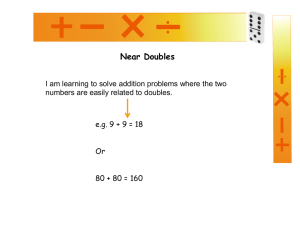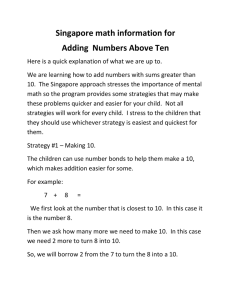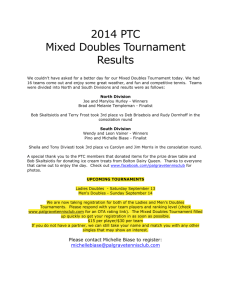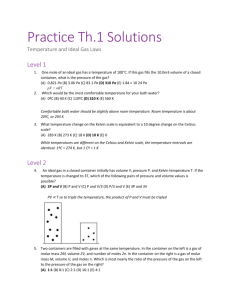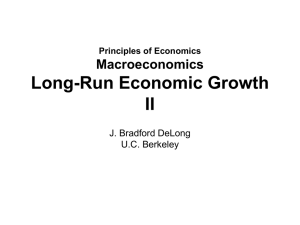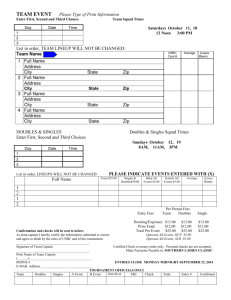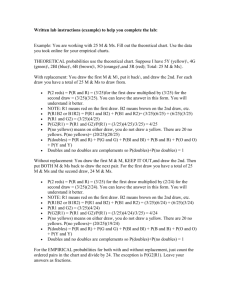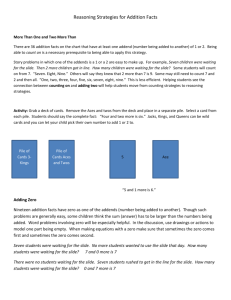Teaching addition facts
advertisement
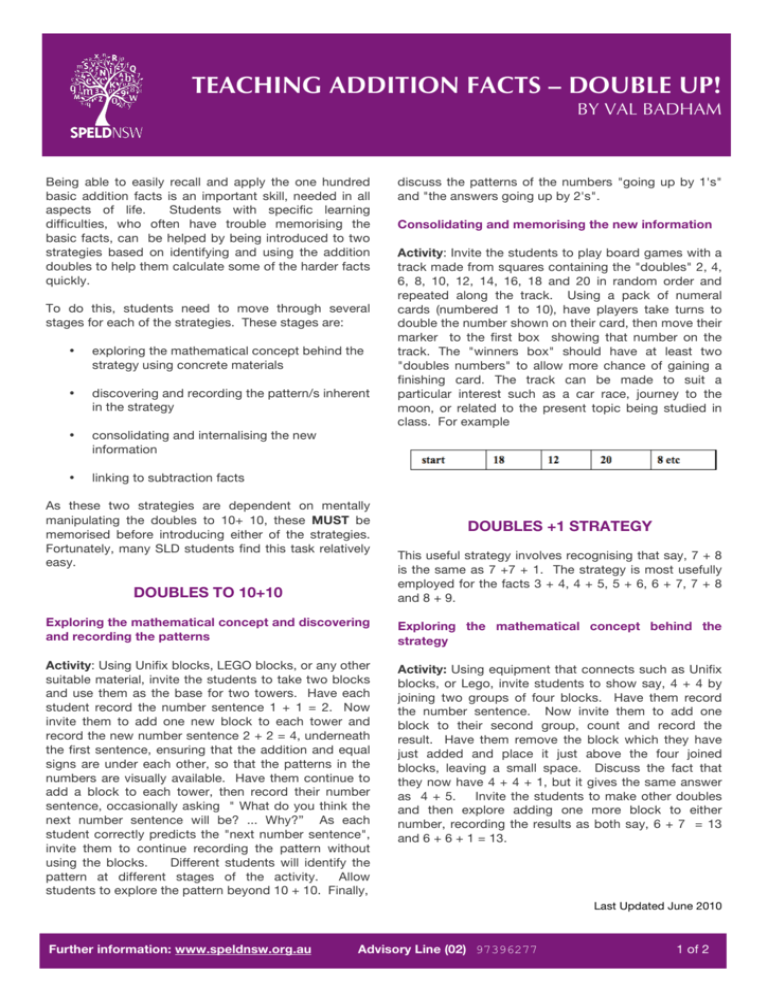
TEACHING ADDITION FACTS – DOUBLE UP! BY VAL BADHAM Being able to easily recall and apply the one hundred basic addition facts is an important skill, needed in all aspects of life. Students with specific learning difficulties, who often have trouble memorising the basic facts, can be helped by being introduced to two strategies based on identifying and using the addition doubles to help them calculate some of the harder facts quickly. To do this, students need to move through several stages for each of the strategies. These stages are: • exploring the mathematical concept behind the strategy using concrete materials • discovering and recording the pattern/s inherent in the strategy • consolidating and internalising the new information • linking to subtraction facts As these two strategies are dependent on mentally manipulating the doubles to 10+ 10, these MUST be memorised before introducing either of the strategies. Fortunately, many SLD students find this task relatively easy. discuss the patterns of the numbers "going up by 1's" and "the answers going up by 2's". Consolidating and memorising the new information Activity: Invite the students to play board games with a track made from squares containing the "doubles" 2, 4, 6, 8, 10, 12, 14, 16, 18 and 20 in random order and repeated along the track. Using a pack of numeral cards (numbered 1 to 10), have players take turns to double the number shown on their card, then move their marker to the first box showing that number on the track. The "winners box" should have at least two "doubles numbers" to allow more chance of gaining a finishing card. The track can be made to suit a particular interest such as a car race, journey to the moon, or related to the present topic being studied in class. For example DOUBLES +1 STRATEGY DOUBLES TO 10+10 This useful strategy involves recognising that say, 7 + 8 is the same as 7 +7 + 1. The strategy is most usefully employed for the facts 3 + 4, 4 + 5, 5 + 6, 6 + 7, 7 + 8 and 8 + 9. Exploring the mathematical concept and discovering and recording the patterns Exploring the mathematical concept behind the strategy Activity: Using Unifix blocks, LEGO blocks, or any other suitable material, invite the students to take two blocks and use them as the base for two towers. Have each student record the number sentence 1 + 1 = 2. Now invite them to add one new block to each tower and record the new number sentence 2 + 2 = 4, underneath the first sentence, ensuring that the addition and equal signs are under each other, so that the patterns in the numbers are visually available. Have them continue to add a block to each tower, then record their number sentence, occasionally asking " What do you think the next number sentence will be? ... Why?” As each student correctly predicts the "next number sentence", invite them to continue recording the pattern without using the blocks. Different students will identify the pattern at different stages of the activity. Allow students to explore the pattern beyond 10 + 10. Finally, Activity: Using equipment that connects such as Unifix blocks, or Lego, invite students to show say, 4 + 4 by joining two groups of four blocks. Have them record the number sentence. Now invite them to add one block to their second group, count and record the result. Have them remove the block which they have just added and place it just above the four joined blocks, leaving a small space. Discuss the fact that they now have 4 + 4 + 1, but it gives the same answer as 4 + 5. Invite the students to make other doubles and then explore adding one more block to either number, recording the results as both say, 6 + 7 = 13 and 6 + 6 + 1 = 13. Last Updated June 2010 Further information: www.speldnsw.org.au Advisory Line (02) 97396277 1 of 2 Trading Games By Val Badham Discovering and recording the pattern Activity: Give the students a worksheet containing all of the doubles from 1 + 1 =... to 10 + 10 = .., neatly written underneath each other and interspersed with the "doubles + 1" facts ( between each double). Invite the students to complete each number sentence, using Unifix blocks if they wish. As a class, discuss any patterns noticed, such as that the answers involve all of the numbers to 20 in order, that each "doubles + 1" fact gives an answer between the two doubles of each of the numbers in the "doubles + 1" fact and any vertical patterns noticed concerning the numbers already on the worksheet. Consolidating the new information Activity: Have each player make a BINGO board by filling the boxes of a 4 by 4 grid randomly with the numbers 5, 7, 9, 11, 13, 15, 17, 19. Each number will need to be written twice so that each box is filled. Now call out random "doubles plus one" facts such as " 5 + 6", then " 8 + 9", etc. As each fact is called, players place a counter on ONE of the matching answers. The first player to complete a line of four counters in any direction is the winner. Example of a bingo board: Exploring the mathematical concept behind the strategy Activity: Using Unifix blocks or LEGO , invite students to show say, 4 + 6 using blocks. Have them record the number sentence. Now invite them to take one block from their second group, move it to the first group and record the result. Discuss the fact that they now have 5 + 5, but it gives the same answer as 4 + 6. Discovering and recording the pattern Activity: Invite the students to make the other near doubles 3 + 5, 5 + 7, 6 + 8 and 7 + 9, recording the results as both say, 5 + 7 = 12 and 6 + 6 = 12 Consolidating the new information Activity: Have each student make a BINGO board by filling the boxes of a 4 by 4 grid randomly with the numbers 8, 10, 12, 14, 16 and 18. Each number will need to be written at least twice so that each box is filled. Now call out random "near doubles " facts such as " 5 + 7", then " 7 + 9", etc. As each fact is called, players place a counter on ONE of the matching answers. The first player to complete a line of four counters in any direction is the winner. CONCLUSION Using the strategies “doubles + 1” and “near doubles” gives SLD students who have not memorised their basic facts the opportunity to quickly calculate a number of facts seen as being amongst the “hardest”, thus reducing the time spent on calculations and allowing these students to spend more time on mathematical processing. NEAR DOUBLES STRATEGY This useful strategy involves recognising that, by subtracting 1 from the higher number and adding it to the lower number a known double can be used to obtain the answer. For example, 6 + 8 is the same as 7 + 7. This strategy is useful for the facts 3 + 5, 4 + 6, 5 + 7, 6 + 8 and 7 + 9 and their reciprocals (Last updated June 2010) Further information: www.speldnsw.org.au Advisory Line (02) 9739 6277 2 of 2
